The content of the article
Vanka wet belongs to the balsamic family. The natural habitat is the subtropical climate of Africa, Asia, the island of Zanzibar, for which balsam is often called a Zanzibar flower. It is believed that the plant gives its owner "masculine power", is able to absorb the diseases of households.
Botanical Description
Indoor flower Ivan wet grows up to half a meter high. The stems are erect, branched, smooth. The leaves are oval or lanceolate, with small teeth along the edges. The color of the foliage is purple-bronze or green.
The buds are laid in the axils of the leaves. In culture, there are varieties with a variety of colors, with the exception of a blue tint. Flowers are simple or double. After pollination, green fruits are tied, as they ripen, they turn into a dry seed box.
Why is the flower called and what is the correct scientific name? The home flower Vanka wet has other names. All of them are due to the properties of the plant. If you touch a ripened seed box, it will immediately open the leaflets, shoot seeds. For this, balsam impatiens was nicknamed "touchy." Another name - “light” - is associated with bright and abundant flowering.
Popular types and varieties
According to various sources, the number of the balsamic genus is from 400 to 550 species. The most common are traditional varieties, which are spreading bushes with red and white flowers.
Gradually they began to be replaced by new hybrid varieties - they are distinguished by more compact, dense bushes, abundant flowering, new colors. Variegate (variegated) plant forms are mainly New Guinean hybrids. The most common are four varieties.
- Balsam waller. The form includes several different hybrid varieties with similar characteristics. The height of the bush is up to half a meter or slightly higher. The stems are bare, highly branched, thick. Thin leaves are held on long petioles. The flowers are separate, large, located at the ends of the shoots. The color is different. Terry forms are found.
- Balsam Peters. Pretty tall, bushy plant. Stems slightly pubescent. The color of the ground part has a bronze hue. Flowers of a fiery color, on long pedicels.
- Balsam Niamese. Bush up to a meter tall, with long, branched stems. The leaves are oblong, densely arranged on the stem. Buds on long pedicels are formed in the leaf sinuses. Flowers are mostly red. There are two-color varieties with an admixture of yellow inclusions.
- New Guinea Balsam. Includes a group of perennials of tall and compact forms. Flowers of different shades, leaves are rather large.
Caring for Vanka wet: what to consider and how to propagate
Balsam is a relatively easy-to-care plant. In the apartment you can create favorable conditions for him, to achieve long, almost year-round flowering. To do this, you must adhere to the recommendations of experienced gardeners.
- Lighting. All balsams love diffused, but bright light. Direct sunlight is undesirable - the plant is protected by tulle on the southern windows. The optimal location is east or west. Balsam responds well to frequent airing of the room or moving to the balcony in warm weather. In summer, planting in the ground with the onset of sustainable heat is allowed. Balsamine does not have a pronounced dormant period, so additional lighting is required in winter.
- Temperature. Balzamin loves heat, calmly withstands heat up to 30 ° C. The optimum temperature is from 20 to 25˚C. In winter, it needs a relative coolness of at least 15 ° C.
- Watering. In spring and summer, it is recommended to water immediately after the drying of the soil surface. In autumn and winter, they adhere to moderate watering - after drying the surface layer of the soil they wait two days. Try to maintain stable soil moisture, use warm, well-maintained water.
- Humidity. At temperatures below 22 ° C, balsam is adapted to dry air. In the heat, frequent spraying is needed.
- Top dressing. Twice a month they make balanced fertilizers for beautifully flowering crops. The bulk of fertilizing occurs during the period of active vegetation. If flowering continues in the winter, occasionally balsam can be fed a half dose of complex fertilizer.
- Pruning. To preserve the decorative effect and stimulate flowering, spring balsamic “haircut” is carried out, cutting the stems to a third or half of the length. As the lateral shoots grow back, the tops are nipped. Weak, unnecessary branches are pruned at any time of the year.
- The soil. The optimal soil for balsam is a mixture of hardwood, humus, turf and sand. All components are taken in the same amount.
- Transfer. The most favorable time for a transplant is the beginning of spring. Young specimens are transplanted every year. If necessary, you can transplant in the summer. Many gardeners recommend using the transshipment method.

Breeding methods
Florists practice seed and vegetative propagation. Both methods are effective, but sowing seeds from a hybrid plant can give unexpected results - the main characteristics of the variety are changing. To obtain seedlings of a certain variety, store seeds are often used.
Seeds
A favorable period for seed propagation is spring. But if you sow the seeds in February, you can get a beautiful flowering bush in May. A mixture of sand and peat is used as a substrate. To obtain strong seedlings, they adhere to a certain sequence of actions.
- Seed preparation. Planting stock is soaked for ten minutes in a weak solution of potassium permanganate, washed and poured with warm water for an hour. Seeds are slightly dried.
- Landing. The container is filled with a pre-prepared substrate. Seeds are distributed on its surface, sprinkled with a thin layer of fine sand on top. The container is covered with a film.
- Germination conditions. Maintain a stable temperature in the range of 18–20 ˚С. Once every two days they open the hotbed, remove the excess condensate, moisten the soil from the spray gun as necessary.If possible, install additional lighting.
- Pick. After the appearance of two true leaves, seedlings can be planted in separate small pots.
- Topping. At the stage of five to nine leaves, a young plant is nipped to stimulate branching.
Cuttings
Reproduction of Vanka wet cuttings allows you to quickly grow a young plant to replace the old. Cuttings are specially cut or apical shoots left after spring pruning are used. Rooting is carried out in the following sequence.
- Preparation of cuttings. The optimal length of the handle is 5–6 cm. The upper leaves are cut in half, the lower ones are completely cut.
- Root extension. Cuttings are placed in water with the addition of tablets of activated carbon and a rooting agent.
- Landing. After root formation, the cuttings are placed in light soil. A week is kept under a film to smooth out temperature differences, maintain stable humidity.
- Topping. In a young plant, pinch a growth point to stimulate branching.
Possible growing difficulties
Unsuitable soil, microclimate, inaccuracies in the conditions of detention are immediately reflected in the appearance of balsam. You can get acquainted with the errors of care and their consequences in the table.
Table - Possible difficulties in growing balsam
| Outward manifestation | Main reasons | Help the plant |
|---|---|---|
| Vanka wet leaves turn yellow | - dry air; - waterlogging of the soil; - rotting of the roots; - excess fertilizer | - Check the root system for rot; - adjust the care regimen |
| Leaves are drooping | - Heat; - lack of moisture | - In the heat spray balsam; - regularly watered, preventing moisture stagnation |
| Vanka's wet buds fall | - dry air; - excess fertilizer; - cold; - drying of the soil; - pest invasion | - During flowering, balsam is kept in moderate heat; - regularly watered; - breed fertilizer according to the instructions |
| Variegated forms lose their characteristic color | - lack of light; - excess fertilizer | - Rearrange balsamin in a bright place or set additional illumination |
| Leaves fall, flowering stops | - Lack of light in combination with low temperature; | - Until the end of flowering, maintain a stable temperature of at least 20 ° C |
| Leaves fade, stems stretch | - Close pot; - lack of nutrients; - poor lighting; - heat | - Balsam is cut, transplanted into a more spacious pot; - adjust the conditions of detention |
| Leaves curl and fall | - Cool content combined with waterlogging | - Reduce watering; - increase the temperature of the content |
Common diseases
Even when being kept in an apartment, some diseases cannot be avoided. Infections carry pests, and the fungus can live in poor soil. The table describes balsamic diseases and their treatment.
Table - Balsam Disease
| The name and cause of the disease | External manifestations | Treatment |
|---|---|---|
| Cucumber Mosaic (virus) | - The leaves become wavy; - yellow spots and holes appear | - The plant is isolated and destroyed |
| Ring mosaic (virus) | - Rounded spots with an annular border appear on the foliage; - growth slows down; - leaves crack |
|
| Brown rot (fungus) | - The stalk becomes thin at the base, turns brown | - In the initial stages of the disease, it is repeatedly sprayed with the Fitosporin preparation; - with a strong defeat, balsam is destroyed |
| Downy mildew (fungus) | - On the outside of the leaves light spots form; - the back of the leaves is covered with a dirty whitish bloom | - Conduct trimming of the affected tissue; - sprayed with Aliet means |
| Bacteriosis (bacteria) | - Black spots appear on the foliage | - carry out pruning; - repeatedly sprayed with fungicides |

Frequent pests
Balsam is susceptible to the attack of many indoor flower pests. Of particular danger are mushroom mosquitoes, aphids, spider mites. More detailed information on pests is given in the table.
Table - Balsam Pests
| Pest | Symptoms | Methods of struggle |
|---|---|---|
| Spider mite | - Yellow specks appear on the foliage; - balsam withers, cobwebs; - upper leaves are deformed | - Balsamine is washed with soap, rinsed under a warm shower; - often sprayed; - increase the humidity in the room; - processed by means of "Aktellik", "Aktara" |
| Whitefly | - The leaves are deformed; - the plant turns yellow, withers | - The bush is washed with warm water; - hang special glue traps; - sprayed with drugs "Mospilan", "Fufanon", "Confidor" |
| Thrips | - Leaves lose their shape, discolor, acquire a silver hue; - brown spots appear on the back side; - holes form on the petals; - pollen crumbles | - Repeatedly, with weekly intervals, sprayed with insecticides Fitoverm, Vermitek |
| Aphid | - On young shoots appear colonies of inactive insects; - the leaves are curled, discolored; - flowering stops; - the plant withers, withers | - Treat all damaged shoots with soap; - sprayed with infusion of needles, tobacco dust; - in difficult cases, the drugs "Actellic", "Karbofos" are used |
| Shield | - Brown plaques appear on the stems; - individual shoots die | - Scabbards are removed with an alcohol wipe; - the plant is sprayed with any insecticide, cover with a bag at night |
| Fools | - Balsam fades, stops growing due to damage to the root system | - Water the soil with Thunder |
| Scyarides (mushroom mosquitoes) | - Small midges similar to mosquitoes fly over a flower; - the plant dies due to damage to the root system by larvae | - Balsam is transplanted with soil replacement; - the soil is shed with the drug "Flies"; - aerosol "Raptor", "Dichlorvos" is sprayed around the plant |
If you properly care for the flower Vanka wet, then the likelihood of infection with pests and diseases will be minimized. In favorable conditions, balsam will bloom almost all year round.

